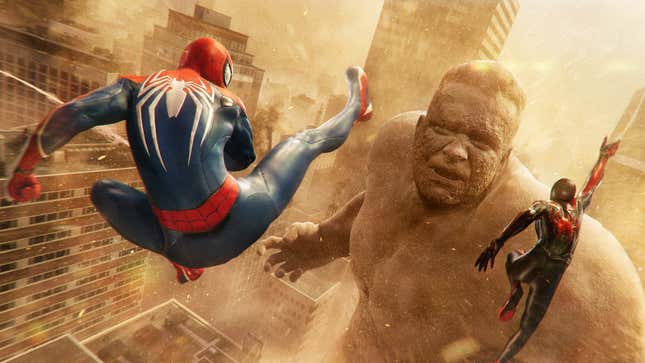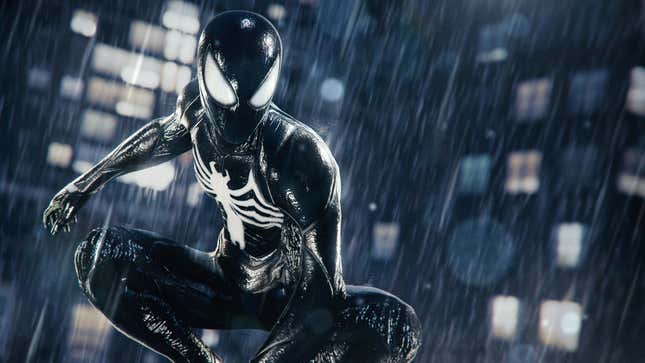Sequels often have a scope problem, especially superheroic ones. Your hero’s been established, they’ve come into their own, and now the temptation is that to test them you have to throw everything and the kitchen sink at them almost immediately. Go big or go home! Marvel’s Spider-Man 2 is certainly no exception to this idea—but where it is, is actually its secret strength.
Out later this week for the PlayStation 5, Marvel’s Spider-Man 2 has a pretty simple logline: what if Marvel’s Spider-Man—the 2018 Insomniac video game that introduced a new, older version of Peter Parker to great superhero gaming success—but more?
In Marvel’s Spider-Man 2, there are bigger villains to face in the form of Kraven the Hunter and Venom, both presented as even bigger threats than the Sinister Six forged in the original game, if not greater in number. The set pieces are bigger, brasher, more wide-reaching in scale and scope—as are the boss fights, which demand more aggression and time from the player to chunk down the similarly (and occasionally laboriously) embiggened health bars that amplify their threat. There’s more Spider-Men, with the arrival of Miles Morales, fresh off his refreshingly intimate PS5 launch game, as a second primary player character. That fact alone means there are more abilities to level up and learn, more gadgets to tinker with; it means there’s even more costumes to unlock and then some, and those costumes draw on a broader scope of Spidey history across mediums in turn (although, perhaps controversially, not every suit from the prior games makes a comeback).

There are more things to do in Insomniac’s take on Marvel’s New York, and the area that you can access of that city is now similarly expanded with the eastern areas of Brooklyn and Queens, and more side quests that go beyond unlocking sets of activities across that map. There are more ways to traverse around all this too, between systemic additions like near-seamless fast travel (RIP to Spidey’s subway card) and swapping between Miles and Peter, and mechanical ones, like addition of wind-current-gliding web wings that let you soar over New York as often as you swing.
Marvel’s Spider-Man 2 is a bigger game than its predecessors in pretty much every sense, but what it brings to the table in and of itself is by and large refinement rather than anything truly additive to its open-world formula. If the mechanical structure of Marvel’s Spider-Man wasn’t your cup of tea in 2018, Marvel’s Spider-Man 2's in 2023 probably won’t be, either. You can quickly dig down and start to examine how the game has evolved that formula in small, smart ways—ways that make some of the repetition of the first game’s world opening up less frictional, ways that expand the variety of things you can do in traversal, combat, or side content without simply cutting what was already there in the first game. But overall, Marvel’s Spider-Man 2 is more Marvel’s Spider-Man.

That might sound like a knock, and will likely be a detractor for anyone especially anticipating a truly additive sequel over an iterative one, but while it may be overly familiar mechanically, Marvel’s Spider-Man 2 is clever refinement on the whole in this regard. What new side activities are present beyond the familiar chases and crimes of the original are inventive and play to the respective strengths and characters of the Spider-hero they’re assigned to (only a few of these activities are truly universal; most are either activities for Peter, or activities for Miles). The way the map and its myriad activities are opened up to you is less restrictive, and from a narrative standpoint builds on Spider-Man: Miles Morales’ distancing of its heroes from the New York police force in ways that support the wider narrative themes (those expecting a return of the Spider-Cop discourse of the original Marvel’s Spider-Man will find very little to chew on here, largely because police forces are pointedly absent). The onboarding of skills and abilities is similarly more smooth, with players mostly capable of doing all the things they could do by the end of the original game mechanically from the get-go, and ready to dive into the new skills and gizmos—like Peter’s Doc Ock/Iron Spider style claws, or Miles’ enhanced bioelectrical abilities, all of which add fun layers to the game’s traversal and combat gameplay while reflecting the increased confidence and experience of its titular heroes.
These evolutions and refinements, however, are minor compared where Marvel’s Spider-Man 2's strengths truly lie—in a narrative that smartly balances the line between the sequel-expected higher stakes and more intimate explorations of its characters. It ultimately reflects on the idea of what Spider-Man means to the broader communities Peter and Miles operate in in New York, as much as what the mask means in the face of those giant, villainous stakes. Set a while after the events of Miles Morales—and with Pete and Miles’ rapport as the Spider-Men well established, and no doubt over their capability nor the validity of their shared mantle ever questioned—Marvel’s Spider-Man 2 takes a lot of the themes from the first game about the complicated balance between the dual personas of being a superhero and explores them in deeper, more nuanced ways. There’s no conflict over discovered identities in this game; the people in Peter and Miles’ lives who matter most already know that they are Spider-Men. Instead, Marvel’s Spider-Man 2 becomes about how that knowledge impacts them and its heroes alike, and about the messy interpersonal drama that can come of wanting something beyond that dueling dichotomy.

Anchored in stellar performances from Yuri Lowenthal and Nadji Jeter as Peter and Miles, respectively, Spider-Man 2's story manages to deal with the expected superheroic ramp-up of stakes from its bigger, brasher adventure—incorporating ruminations on iconic comics arcs like Kraven’s Last Hunt, and, of course, the Alien Costume Saga that gave us Venom—while intimately exploring the relationship between Peter and Miles, and their own own friends and family. The same smart balance of the superhero fantasy and the personal drama that Marvel’s Spider-Man reflected in Peter’s struggle is built on here—albeit arguably darker given the subject matter, as the mere presence of the symbiote gives the cast a harsher bent to draw on. But while that is still the big appeal and where Marvel’s Spider-Man 2's love of the source material still shines through the brightest, arguably what makes the sequel work at all beyond being more of the same but a bit better is the space its narrative dedicates to an intimacy beyond the superhero spectacle.
This is arguably where Marvel’s Spider-Man 2 draws most from Miles Morales rather than Marvel’s Spider-Man, with the smaller scale of that game largely given way to the sequel’s desire to be bigger and broader. Instead, Miles Morales’ intimate scale is felt a more in the narrative sense here, with as much time given to broadening the game’s perspective of New York and the people who live in it as much as there is wild Kraven chases or Venom’s symbiote-infused chaos. More so than in either prior game, there’s a real sense of Peter and Miles’ place in a world much bigger than either of them, and not just to their immediate circles of family and friends. Whether it’s in the aforementioned distancing of Peter and Miles’ relationship with the police to focus on a more community-driven lens of New York, or how the game uses its side stories less as ways to simply expand the number of things to do on the map, and more to broaden the ways Peter and Miles get to actually interact with the people around them, Marvel’s Spider-Man 2 never lets its necessity to be bigger and more than its predecessors get in the way of telling the sorts of smaller, messier, more intimate stories that make Spider-Man as a hero so beloved in the first place. There’s still plenty of bombastic setpieces and dire stakes for Peter and Miles to both overcome, but crucially this also means that bombast and threat feels genuinely earned, because the world of characters beyond them established here is much more keenly felt.

It took a very long time to get Spider-Man another great entry in his gaming history before Marvel’s Spider-Man, and its sequel is now letting that great streak continue and flourish—while letting more Spidey-heroes like Miles in on the party along the way. If Marvel’s Spider-Man 2 is a game of smart refinements on the whole, that’s best reflected in how it delivers a narrative that still hits the emotional highs and big action moments of the original game, while building on its dramatic underpinnings with greater depth, and greater nuance, in ways that make it a story worth telling. The game itself might not be as vastly changed mechanically as some people might hope from a fully-fledged sequel, but that matters far less in what Marvel’s Spider-Man 2 achieves by using that broadened scope to deliver a richer, interestingly messier, and more satisfyingly matured experience. There’s greater power here, yes—but there’s greater responsibility, too, and no good Spider-Man story is anything without that.
Marvel’s Spider-Man 2 hits PS5 on October 20.
Want more io9 news? Check out when to expect the latest Marvel, Star Wars, and Star Trek releases, what’s next for the DC Universe on film and TV, and everything you need to know about the future of Doctor Who.
